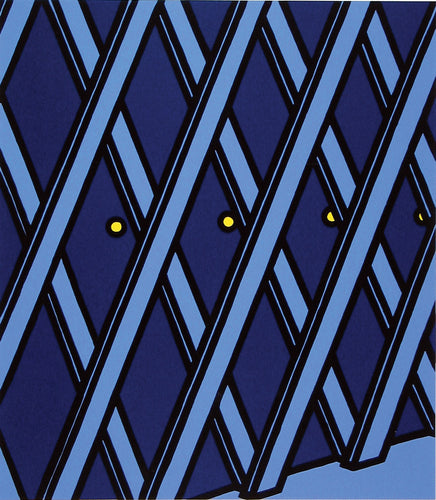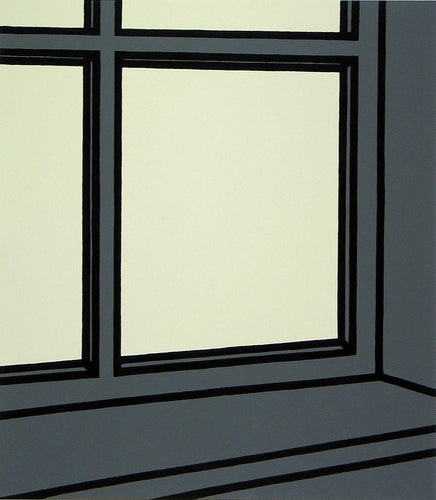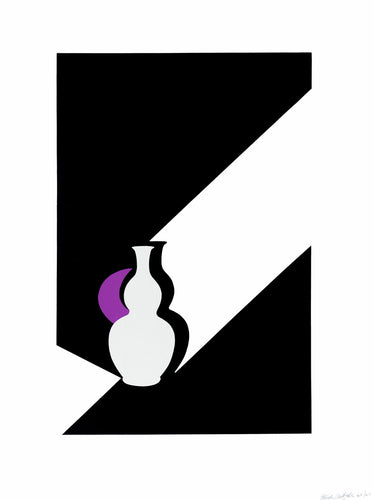No artist of his generation has contemplated the comedy of life with greater intelligence, wit or courage than Patrick Caulfield. - Mel Gooding
Towards the end of the 1960s, the Petersburg Press approached British artist Patrick Caulfield with a commission to produce a limited edition book which they would then publish. Caulfield was to choose his own subject: the poetry of French nineteenth-century writer Jules Laforgue, whom he had read as a student.
 (above) 'All the benches are wet, the woods are so rusty'; strong colour and bold black outlines typify the work of Patrick Caulfield
(above) 'All the benches are wet, the woods are so rusty'; strong colour and bold black outlines typify the work of Patrick Caulfield
Though he died at the tender age of 27, Laforgue’s poetry had a sustained influence on early modernist writers, including T. S. Eliot and Ezra Pound. Born in 1860, he was one of the very first innovators in Free Verse, where an unshackling from the perceived constraints of metre and stanza drew more and more poets to abandon traditional styles and experiment in their writing.
 (left) 'And I am alone in my house'; (right) 'I've only the friendship of hotel rooms'; Caulfield's prints offer 'impressions', rather than illustrations, of Laforgue's poetry
(left) 'And I am alone in my house'; (right) 'I've only the friendship of hotel rooms'; Caulfield's prints offer 'impressions', rather than illustrations, of Laforgue's poetry
By the early 1880s Laforgue had begun to nurture a growing interest in the world of art and art criticism, and under the employment of Charles Ephrussi, a wealthy collector of contemporary art, he was introduced to the work of early Impressionism. The movement had a profound effect on the poet, which scholars of his work suggest can be found in much of his poetry.

day becomes night in these four screenprints, images hinting at the banality of everyday existence
Whether Caulfield was aware of Laforgue’s relationship with Impressionism or not, ‘impressions’ – suggestions, rather than descriptions or depictions of Laforgue’s poetry – are what Caulfield presents the viewer, as he has noted himself:
They are not illustrations but complementary images. There are few visually descriptive lines in Laforgue. The images suggest the things I have imagined the poet seeing when he wrote the poem…
'She fled along the avenue'; heightening the mundane to the vibrant: vivid colour abounds in these simple images
Caulfield’s imagery aptly matched the melancholy of Laforgue’s verse. Like the artistic equivalent of a Raymond Carver short story, each print captures the unending stillness that pervades much of our everyday living, portrayed in bright block colour as if to try and heighten the mundane to the vibrant: a tooth-jangling lemon yellow clock still ticks away the dull hours; the monotony of a kitchen cupboard throbs in crimson red, punctured by two cyan handles, in We wanted to bleed the silence.
 'twilight blues and purples to virulent greens and deepest black' - (above) 'She'll have forgotten her scarf'
'twilight blues and purples to virulent greens and deepest black' - (above) 'She'll have forgotten her scarf'
12 of Laforgue’s poems were used, Caulfield producing a suite of 22 screenprints to accompany them. His choice of print medium best facilitated the sheer strength of colour which characterized the series, from its twilight blues and purples to virulent greens and deepest black.

 'each print captures the unending stillness that pervades much of our everyday living'
'each print captures the unending stillness that pervades much of our everyday living'
While in colour and intensity they are typical of the dominant Pop-Art movement of the 1960s, Caulfield’s Laforgue prints have a subject-matter and source that is personal and peculiar, making for a strange and enticing suite of images.










